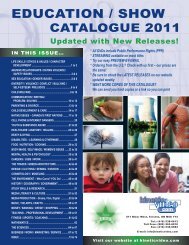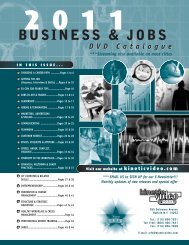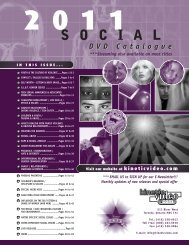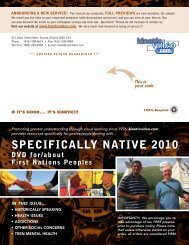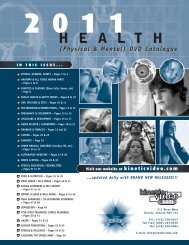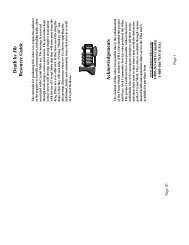WHAT'S NEW @ KINETIC???!!! - Kinetic Video
WHAT'S NEW @ KINETIC???!!! - Kinetic Video
WHAT'S NEW @ KINETIC???!!! - Kinetic Video
Create successful ePaper yourself
Turn your PDF publications into a flip-book with our unique Google optimized e-Paper software.
THE BASICS OF ANATOMY SERIES<br />
THE NERVOUS SYSTEM: Neurons, Networks & the Brain<br />
Begins by examining the structure and function of<br />
neurons; resting, action and post-synaptic potentials; and<br />
reflexes and neural networks. The peripheral, somatic,<br />
autonomic, sympathetic and parasympathetic nervous<br />
systems are introduced before looking at the central<br />
nervous system. After describing spinal cord structure and<br />
function the program then examines the human brain<br />
including the medula, pons, and cerebellum of the<br />
hindbrain; the recticular formation of the midbrain; and<br />
the thalamus, limbic system and cerebral cortex of the<br />
forebrain. 39 minutes<br />
IMMUNOLOGICAL SYSTEM: Recognition, Attack and<br />
Memory<br />
Starts by looking at external barriers to microbial attack<br />
such as the skin and mucus membranes and non-specific<br />
internal defenses such as macrophages, natural killer<br />
cells, and the inflammatory response. The program then<br />
delves into the immune response including the recognition<br />
of invaders by antibodies and T-cell receptors, the<br />
destruction of invaders by antibodies and cytotoxic Tcells,<br />
and the immunity conferred by memory cells. A<br />
discussion of how vaccinations work and current AIDS<br />
research concludes the program. 33 minutes<br />
THE ENDOCRINE SYSTEM: Molecular Messengers,<br />
Chemical Control<br />
First looks at the chemical structure of various hormones,<br />
the hormone receptors found on target cells, and the<br />
feedback mechanisms that regulate hormone levels. After<br />
explaining the difference between exocrine and endocrine<br />
glands the program then looks at the various endocrine<br />
glands and organs including: the hypothalamus; the<br />
pituitary, thyroid, parathyroid and adrenal glands; the<br />
pancreas, testes and ovaries; and organs such as the<br />
thymus, kidneys, stomach, small intestine and heart that<br />
produce hormones. 32 minutes<br />
RESPIRATION AND CIRCULATION: Gas Exchange,<br />
Molecular Transport<br />
Looks at the flow of air through the conducting portions of<br />
the respiratory system to the alveoli before examining:<br />
the role of hemoglobin in gas exchange and O2 and CO2<br />
transport in the blood; the operation of the respiratory<br />
control center; and the mechanics of breathing. The<br />
program then investigates the composition of blood and<br />
how it flows through the heart, arteries, capillaries and<br />
veins before looking at the role of the lymphatic system in<br />
fighting infection, transporting fats, and returning<br />
interstitial fluid to the blood. 35 minutes<br />
DIGESTION AND EXCRETION: Absorption, Excretion, and<br />
Homeostasis<br />
First examines the mechanical and chemical breakdown of<br />
food that occurs in the mouth and stomach before looking<br />
at digestion and absorption in the small intestine and the<br />
enzymes and other chemicals secreted by the liver, gall<br />
bladder, and pancreas that aid in the process. The<br />
program then looks at the synthesis of vitamins by<br />
bacteria in the large intestine and then goes on to explore<br />
the complex structures in the kidney that allow them to<br />
filter wastes out of the blood while returning water and<br />
nutrients. 30 minutes<br />
MUSCULAR, SKELETAL, AND INTEGUMENTARY SYSTEM:<br />
Defining Our Form<br />
Begins by introducing the dermis and epidermis of the<br />
skin; the sweat and sebaceous glands; and the skins role<br />
in protecting against microbial invasion, ultra-violet<br />
radiation and in producing vitamin D. The program then<br />
looks in-depth at the structure and function of skeletal,<br />
cardiac and smooth muscle before looking at the structure<br />
of cartilage and bone and the skeletal systems role in<br />
protecting vital organs, producing blood cells, storing<br />
nutrients and in conjunction with the muscular system,<br />
producing movement. 28 minutes<br />
#12250/0198 Six programs 2008. $119.95 each or Series $629.95 Grades 8 to 12<br />
THE SECRET LIFE OF THE BRAIN “Highly Recommended”<br />
A startling new map of the human brain has emerged during the past decade of neuroscience research, contradicting much of<br />
what was previously believed. Narrated by Blair Brown and directed by David Grubin, this series tells stories through a mix of<br />
personal histories, expert commentary, and cutting-edge animation. Viewers learn startling new truths about the brain.<br />
THE BABY'S BRAIN: Wider Than the Sky - Less than a month after conception, human brain cells are developing at the rate<br />
of 500,000 per minute. Billions of cells linked by trillions of connections form the brain, but how does it organize itself? What<br />
are the roles played by genetics and environment in brain development? Episode One traces formation of the infant brain<br />
through age one, the period when it is most open to molding through external influence and experience.<br />
THE CHILD'S BRAIN: Syllable from Sound<br />
The explosion of language in young children provides a dramatic illustration of the young brain at work. How do we learn to<br />
talk? How do we learn to read? Unlike adults, in whose brains most linguistic activity is restricted to the left hemisphere, very<br />
young children respond to language with the entire brain. But what happens when the brain is physically compromised? And<br />
what are the physical roots of language disorders such as dyslexia?<br />
THE TEENAGE BRAIN: A World of their Own - Parents who believe teenagers are different from other humans may be<br />
comforted to learn that it is literally true. During puberty the brain is a work in progress, teeming with hormones; areas that<br />
direct reasoning and impulse control are still in development. During adolescence, people are especially susceptible to<br />
addiction and schizophrenia, two areas under intensive study and benefiting from increased understanding of brain function.<br />
THE ADULT BRAIN: To Think By Feeling<br />
The brain is the seat of both intellect and emotion, and this episode chronicles the critical balance between these processes<br />
and explores what happens when the balance is lost. Scientists draw insight from the stories of a stroke victim and a sufferer<br />
of post-traumatic stress disorder, and break new ground in the struggle to understand and treat depression.<br />
THE AGING BRAIN: Through Many Lives<br />
For years, science has suggested that we lose vast numbers of brain cells as we grow older; now it turns out that this is not<br />
true -- in fact, healthy brains continue to produce new neurons well into the 70s. Drawing on the most recent neuroscience<br />
discoveries, this episode presents a new view of how the brain ages, focusing in part on the remarkable strides being made in<br />
understanding stroke, Alzheimer's Disease and Parkinson's Disease.<br />
#12610/1725 Five 60-minute programs on 3 DVDs $179.95 for the set *CC<br />
23





